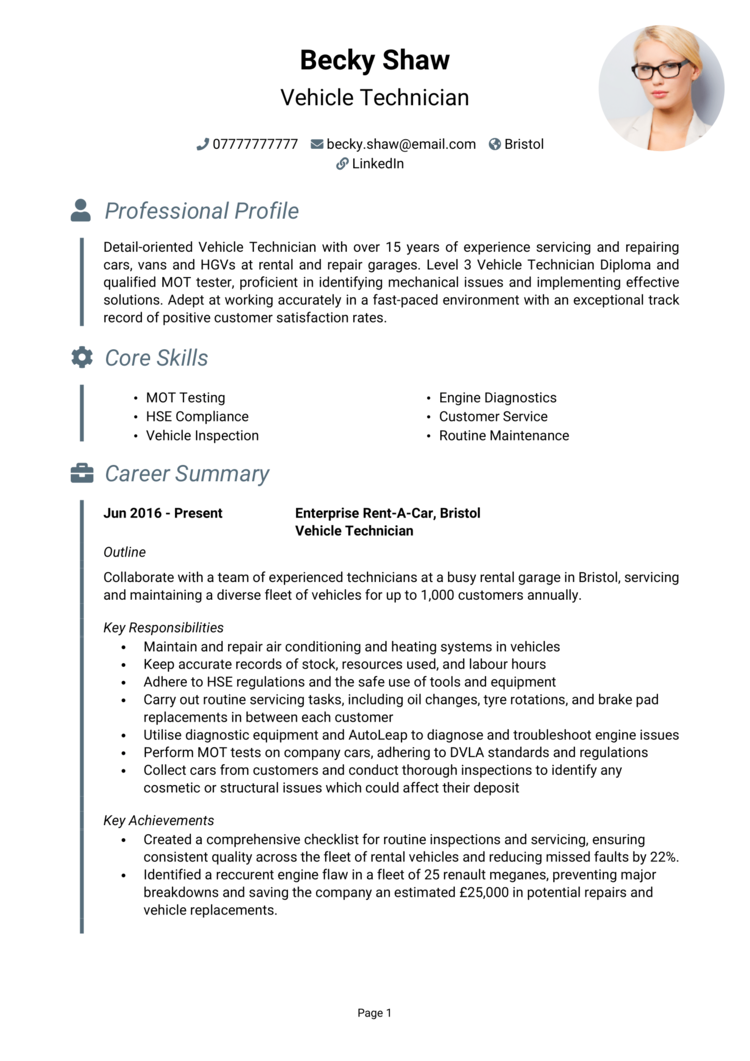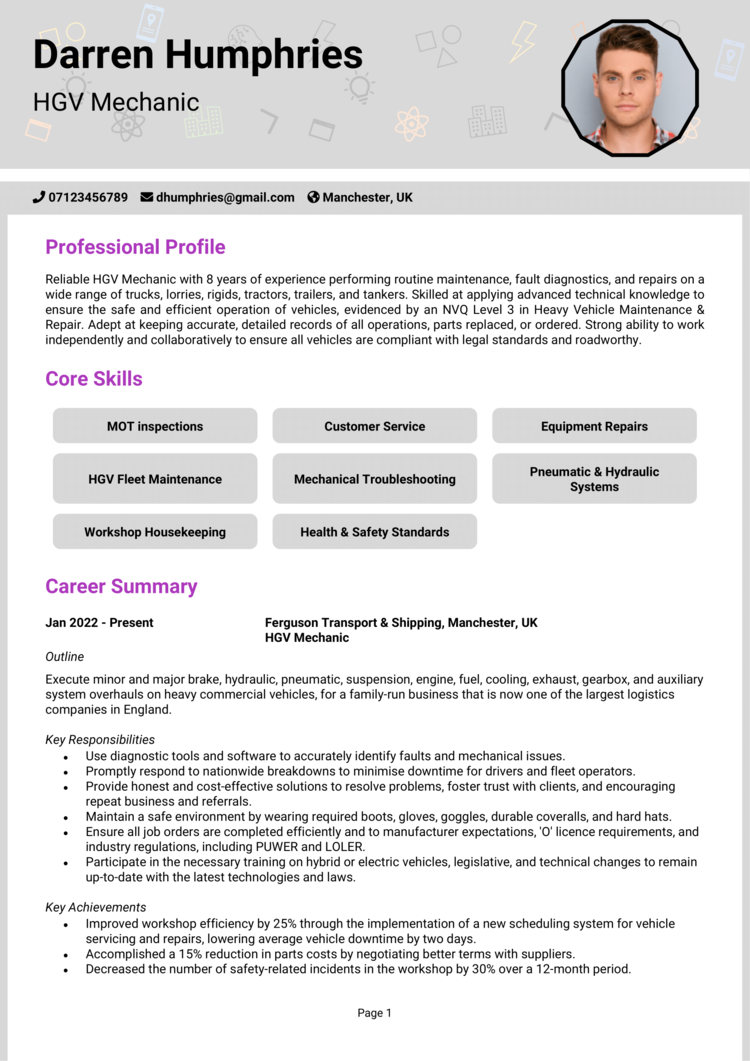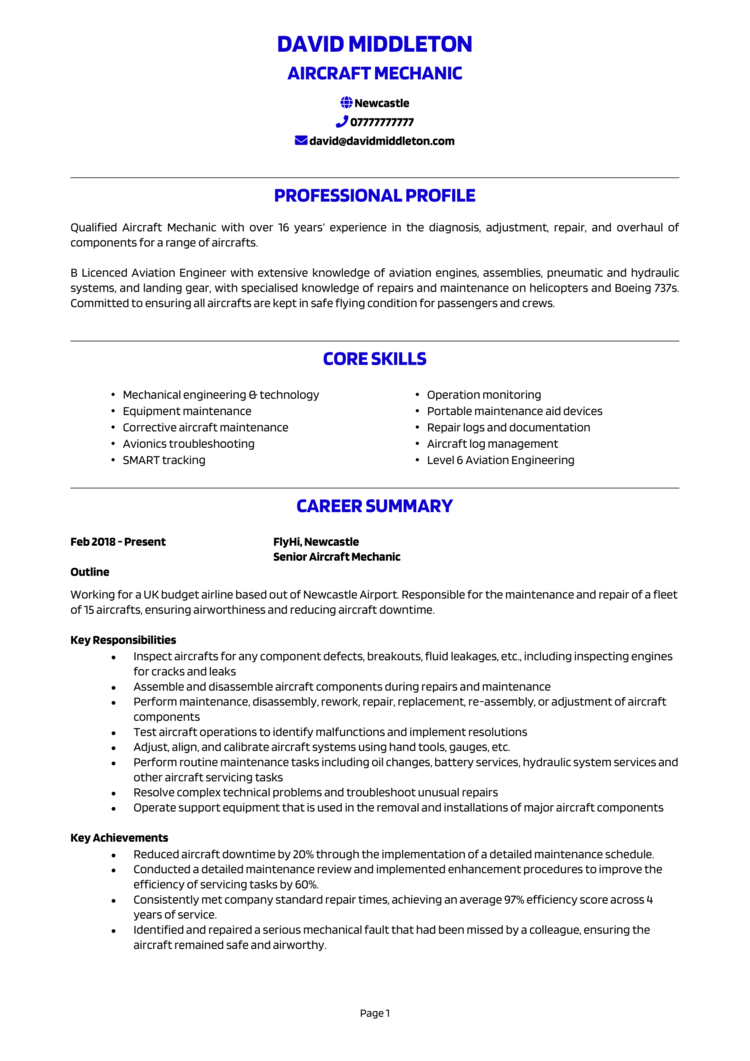Engines, transmissions, and electrical systems – if it moves, you can probably fix it. As a mechanic, you’re the key to making sure well-oiled machines run like… well-oiled machines.
But before you can roll up your sleeves in your next job, you need to get through the first challenge – landing the role. This guide and its Mechanic CV examples will help showcase your technical expertise and problem-solving skills – so you can secure the job and get back to what you do bes
Mechanic CV example

Vehicle Technician CV example

HGV Mechanic CV example

Aircraft Mechanic CV example

How to write your Mechanic CV
Learn how to create your own interview-winning Mechanic CV with this simple step-by-step guide.
In this guide, you’ll learn everything about writing a CV, from formatting it to highlighting your most valuable mechanic skills. You’ll be able to present your experience in a way that ensures hiring managers know you’re the right person to keep things running smoothly.
Structuring your Mechanic CV


A mechanic’s job is all about precision and efficiency – your CV should be no different. Keep it structured so employers can quickly assess your expertise and experience with ease: don’t let your skills get lost in a disorganised mess.
Here’s the structure you should follow:
- Name and contact details – Display your personal details clearly at the top so employers can get in touch easily. Adding a picture of yourself is always optional.
- Profile – Begin with a concise summary that highlights your expertise and what you bring to the role.
- Core skills – Highlight your strongest skills, such as diagnostics and repairs, that align with the role’s requirements.
- Work experience – Start with your most recent role and work backwards, showcasing achievements and responsibilities.
- Education – Mention your degrees, diplomas, and any training that supports your career path.
- Additional info – Include any additional details, like hobbies, awards, or memberships, that highlight your skills or personality.
The correct format for a Mechanic CV


A CV full of clutter is like a workshop full of loose parts – frustrating and very inefficient. You should make your CV as easy and as pleasant for recruiters to read as possible, so don’t let your skills get overshadowed by formatting mistakes.
Here are some useful tips for your CV’s format:
- Bullet points – These help recruiters skim through your accomplishments quickly and easily.
- Divide sections – Break your CV into distinct sections with clear headings for smooth navigation.
- Use a clear and readable font – Use a simple, professional font and keep your layout uncluttered for maximum readability.
- No more than 2 pages – Go for 2 pages max – enough length to highlight your expertise while keeping the recruiter interested.
Mechanic CV profile


Your CV profile is like a quick diagnostic check – it tells hiring managers at a glance what you bring to the job. With a brief outline of your most important skills and experience, you should make recruiters understand the benefits they’d find in hiring you instead of another candidate.
Mechanic CV profile examples
Profile 1
Skilled Mechanic with four years of experience diagnosing, repairing, and maintaining vehicles in busy automotive workshops. Proficient in using diagnostic tools, conducting engine repairs, and performing routine servicing on petrol and diesel vehicles. Experienced in handling brake systems, transmissions, and electrical troubleshooting. Dedicated to providing high-quality service and ensuring vehicle safety and reliability.
Profile 2
Experienced Mechanic with three years of expertise in heavy-duty vehicle maintenance, specialising in truck and fleet servicing. Skilled in hydraulic systems, engine diagnostics, and preventive maintenance to minimise vehicle downtime. Proficient in using OBD-II scanners, hand tools, and welding equipment for structural repairs. Passionate about optimising vehicle performance and ensuring compliance with industry safety standards.
Profile 3
Versatile Mechanic with over six years of experience working on both light and commercial vehicles, including hybrid and electric models. Skilled in diagnosing faults, replacing worn components, and conducting MOT inspections. Proficient in using automotive software such as AutoEnginuity and Bosch ESI[tronic] for accurate diagnostics. Committed to delivering high-quality repairs and outstanding customer service.
What to include in your Mechanic CV profile
Make sure your profile includes the following:
- Types of vehicles worked on – Whether it’s cars, trucks, motorcycles, or heavy machinery, make it clear.
- Key mechanical expertise – Mention skills like engine diagnostics, suspension repairs, or electrical troubleshooting.
- Efficiency and problem-solving – Highlight your ability to diagnose and fix issues quickly.
- Customer service skills – If you’ve worked directly with customers, emphasise your communication and service abilities.
- Workshop tools and technology – Mention experience with diagnostic software, hydraulic lifts, or other key tools.
How to present your core skills section properly


A strong core skills section gives employers a quick way to assess whether you’ve got what they’re looking for. When they open up any CV, they’re immediately scanning for keywords: so make them obvious and clear.
The best part? CV skills are very easy to tailor to the role: if the role focuses on commercial vehicle maintenance, highlight fleet servicing and heavy-duty engineering repairs. If it’s a role in a dealership, focus on diagnostics, manufacturer-specific training, and customer service.
Key skills that make a Mechanic CV stand out
- Vehicle Diagnostics – Using diagnostic tools and manual testing methods to identify mechanical and electrical issues.
- Engine Repair and Maintenance – Servicing, repairing, and rebuilding engines to ensure optimal performance.
- Brake System Servicing – Inspecting, repairing, and replacing brake components for vehicle safety.
- Transmission Repair – Diagnosing and repairing manual and automatic transmissions, including fluid changes and rebuilds.
- Suspension and Steering Systems – Maintaining and repairing shock absorbers, struts, and alignment systems.
- Electrical System Troubleshooting – Identifying and fixing faults in wiring, batteries, alternators, and ignition systems.
- Air Conditioning and Heating Repair – Servicing climate control systems to maintain proper functionality.
- Tyre Fitting and Balancing – Replacing, rotating, and aligning tyres to enhance vehicle handling and safety.
- Welding and Fabrication – Using welding techniques to repair or modify vehicle parts and bodywork.
- Compliance with Safety Standards – Ensuring all repairs and maintenance meet industry regulations and manufacturer specifications.
Showcasing your work experience


While listing your skills is always good, employers want to see how you’ve applied your knowledge to keep vehicles running safely and efficiently in practical settings. Your work experience should be more than just a list of jobs, but an insight into what you can do under the bonnet.
List your roles in reverse chronological order, ensuring each entry is structured with bullet points. If you’re a newly qualified mechanic, highlight any apprenticeships, internships, or hands-on training experience.
How to structure jobs

- Outline – Introduce the garage, dealership, or workshop you worked at, along with your role.
- Responsibilities – List key tasks, such as diagnosing faults, carrying out repairs, and conducting routine servicing. Use action words like “diagnosed”, “repaired”, and “maintained”.
- Achievements – Highlight measurable results, such as improved turnaround times, increased customer satisfaction, or cost-saving maintenance solutions.
Example jobs for Mechanic
Automotive Mechanic | Torque Repairs
Outline
Diagnosed and repaired mechanical and electrical faults in a variety of vehicles at an automotive repair centre, ensuring optimal performance, road safety, and compliance with manufacturer specifications.
Responsibilities
- Conducted routine servicing, including oil changes, brake pad replacements, and tyre rotations.
- Diagnosed engine and transmission issues using OBD-II scanners and manufacturer-specific software.
- Performed repairs on exhaust systems, suspension components, and cooling systems.
- Ensured compliance with safety regulations by inspecting and testing vehicle components.
- Provided detailed reports on vehicle conditions and recommended necessary repairs to customers.
Achievements
- Reduced vehicle repair turnaround time by 20 percent through improved workflow efficiency.
- Improved customer satisfaction ratings by consistently delivering high-quality workmanship.
- Trained junior mechanics on diagnostic procedures and repair techniques.
Fleet Mechanic | RoadLinks Logistics
Outline
Maintained and repaired a fleet of commercial trucks and vans for a national logistics company, ensuring vehicles remained roadworthy, minimised downtime, and met all safety regulations.
Responsibilities
- Performed scheduled maintenance and emergency repairs on diesel and petrol-powered fleet vehicles.
- Diagnosed and resolved mechanical issues, including transmission failures and fuel system malfunctions.
- Managed parts inventory and ordered necessary components to reduce downtime.
- Used hydraulic lift systems to inspect undercarriages and perform necessary repairs.
- Kept detailed maintenance records for each vehicle to track service history and compliance.
Achievements
- Reduced fleet downtime by 30 percent through proactive preventive maintenance.
- Extended vehicle lifespan by implementing new servicing procedures.
- Recognised for ensuring 100 percent compliance with road safety and emission standards.
Mechanic | EcoDrive Services
Outline
Specialised in diagnosing and repairing hybrid and electric vehicles at a specialist EV workshop, ensuring optimal efficiency, battery performance, and adherence to high-voltage safety protocols.
Responsibilities
- Serviced and repaired hybrid and electric powertrains, including battery packs and regenerative braking systems.
- Used advanced diagnostic tools to troubleshoot software and electrical faults.
- Conducted safety inspections on high-voltage components and ensured proper handling procedures.
- Repaired and replaced inverters, electric drive units, and charging systems.
- Advised customers on best practices for extending battery life and optimising energy efficiency.
Achievements
- Reduced diagnostic times by 25 percent through effective troubleshooting methods.
- Successfully repaired over 300 hybrid and EV models, maintaining a 98 percent customer satisfaction rate.
- Trained fellow mechanics on high-voltage safety protocols and advanced diagnostics.
Education section


A good mechanic is always learning, and employers want to see proof of your technical training. But they value real-world experience more highly, so keep your education section brief and to the point.
List your formal qualifications, starting with the most recent. If you’ve completed specialist training, such as hybrid vehicle servicing or advanced diagnostics, highlight it here.
Best qualifications for Mechanics
- NVQ/SVQ Level 3 in Vehicle Maintenance and Repair – A key qualification for professional mechanics in the UK.
- IMI (Institute of the Motor Industry) Certification – Recognised in the automotive sector.
- City & Guilds Diploma in Light Vehicle Maintenance – Covers essential repair and servicing skills.
- MOT Tester Qualification – A valuable certification if you conduct vehicle inspections.
- Hybrid and Electric Vehicle Training – Important as more vehicles transition to electric power.





